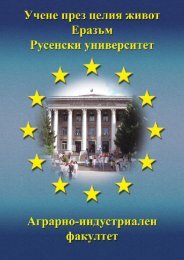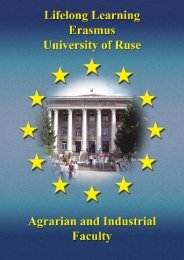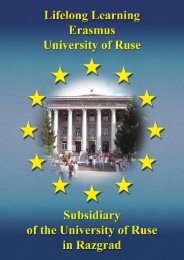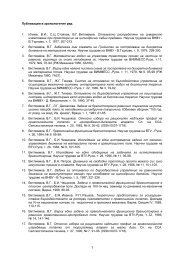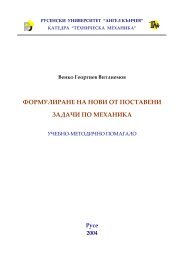Erasmus ECTS Information Package
Erasmus ECTS Information Package
Erasmus ECTS Information Package
Create successful ePaper yourself
Turn your PDF publications into a flip-book with our unique Google optimized e-Paper software.
<strong>Erasmus</strong> <strong>ECTS</strong> <strong>Information</strong> <strong>Package</strong><br />
Faculty of EEEA<br />
3125 Practical Training<br />
ЕСТS credits: 4<br />
Weekly classes: 0lec+0sem+0labs+0ps<br />
Assessment: preliminary exam<br />
Type of exam: oral and written<br />
Department involved:<br />
Department of Telecommunications<br />
Faculty of Electrical Engineering, Electronics and Automation<br />
Lecturers:<br />
Assoc. Prof. Krasimir Petrov Manev, MEng, PhD, Dept. of Telecommunications, tel.: 888 780,<br />
E-mail: kmanev@ecs.uni-ruse.bg<br />
Abstract:<br />
The aim of the course is to help students assimilate the acquired theoretical knowledge and practical skills from<br />
the Telecommunication Systems degree course and to obtain new specific knowledge and skills under the<br />
conditions of real businesses and organizations engaged in design, introduction, exploitation and maintenance of<br />
communication-information systems.<br />
Course content:<br />
Introduction to the structure, character and the activities of different subdivisions in a specific organization.<br />
Studying the widespread communication-information systems, their constructive and technological parameters and<br />
characteristics, functional potentialities and special exploitation features. Direct participation depending on the<br />
trainee’s official position in the exploitation and maintenance of the communication equipment.<br />
Teaching and assessment:<br />
The practical training is organized in the period fixed in the course schedule. It is conducted in enterprises,<br />
companies, organizations with modern manufacturing facilities or in organizations where contracts for practical<br />
training have been concluded. The industrial training can be carried out in an enterprise offered by the student but<br />
on condition that it is properly equipped to enable the implementation of the module objectives and tasks (tutor’s<br />
permission needed).<br />
3121 Television Systems<br />
ЕСТS credits: 6<br />
Weekly classes: 3lec+0sem+0labs+2ps+0,5p<br />
Assessment: exam<br />
Type of exam: written and oral<br />
Department involved:<br />
Department of Telecommunications<br />
Faculty of Electrical Engineering, Electronics and Automation<br />
Lecturers:<br />
Assoc. Prof. Teodor Bozhidarov Iliev, MEng, PhD, Dept. of Telecommunications, tel.: 888 841,<br />
E-mail: tiliev@ecs.uni-ruse.bg<br />
Asistant Professor Grigor Yordanov Mihaylov, MEng, Dept. of Telecommunications, tel.: 888 836,<br />
E-mail: gmihaylov@uni-ruse.bg<br />
Abstract:<br />
The subject aims to acquaint the students with the perceptual properties of human vision, representation of color<br />
features, mapping of motion into image plane, segmentation and decomposition of video signals. The second part<br />
of the course focuses on television signals and their properties, and terrestrial broadcasting networks. The<br />
technical operating of CRT and LCD displays, principles of color television standards like PAL, SECAM and NTSC<br />
are discussed, too.<br />
Course content:<br />
The physical fundamentals of television (light, human eye, color vision). Principle of television, synthesis of<br />
television images. Parameters of television images. Television signal and its properties. Television broadcasting.<br />
Light – signal transformers. Correction methods of signal distortions. Signal – light transformers. Television<br />
cameras. Television standards.<br />
Teaching and assessment:<br />
The lecture topics enable the students to get acquainted with the main theoretic issues of the fundamentals of<br />
television before doing the practical exercises. Students investigate the characteristics of television signals, using<br />
the available laboratory installations and measurement instruments.<br />
Lectures discuss mainly the fundamentals of television, while the practical classes deal with the characteristics of<br />
television signals. Method of assessment: written and oral exam on 2 questions from the course prospectus.<br />
202



